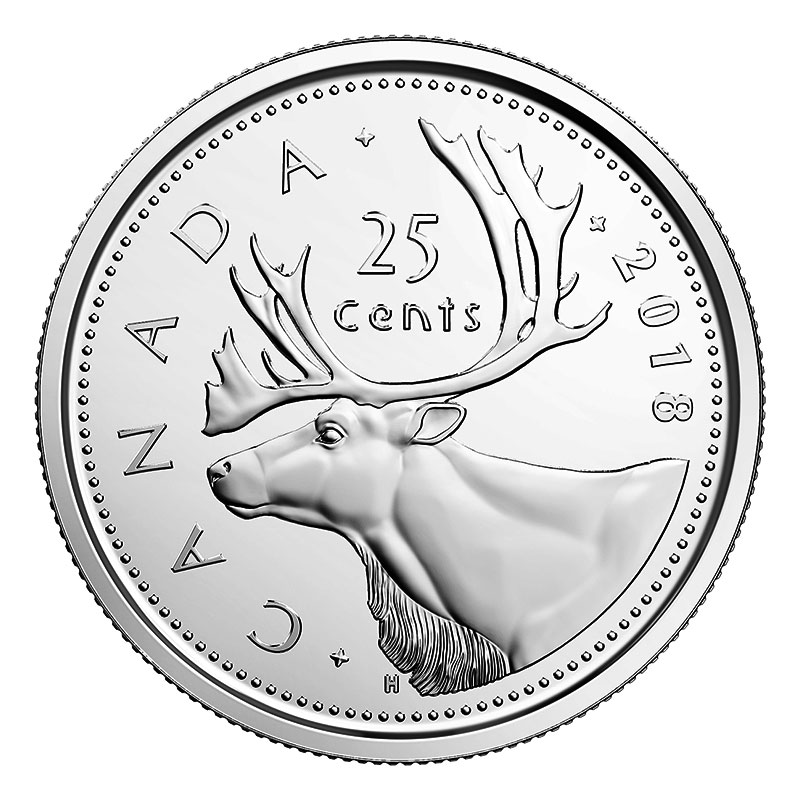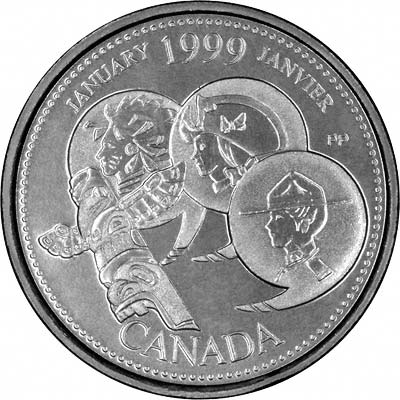Canadian Quarter
>Find valuable buying/selling information on several (29) of the most popular Canadian silver coins in my book The Last Canadian 80 Percent Silver Coins. Available as an eBook.
. In 1967, some of the Canadian dimes and quarters were minted in 80% silver while the remainder were minted in 50% silver. In 1968, some of the Canadian dimes and quarters were minted in 50% silver while the remainder were minted in 99.9% nickel. The nickel versions will stick to a magnet. Canadian Quarters. The Canadian 25-cent piece usually comes with a caribou on one side and the Canadian monarch on the other. Emanuel Hahn created the caribou image in 1937, and while it’s periodically been replaced for special occasions, such as Canada’s 125th birthday, it continues to be used today. Like most Canadian coins, the quarter is made from plated steel. Canadian Twenty Cent Pieces and Quarters from one of Ohio's largest and oldest coin dealers. Satisfaction Guaranteed.
Silver Canadian coins have a most interesting history. The coins that were minted at London's Royal Mint beginning in 1858 were five-cent, ten-cent and twenty-cent coins containing 92.5 percent silver. In 1870, the twenty-five cent coin (silver Canadian quarter) replaced the twenty-cent coin and the fifty-cent coin (silver Canadian half-dollar) was introduced.
Some of these early silver coins were minted by the Heaton Mint (a privately owned mint located in Birmingham, England) and bear the 'H' mint mark. In 1908, the Royal Canadian Mint was established to begin production of Canada's coins.
Silver coins with 92.5 percent silver fineness...

Canadian Dime(1858-1919): Silver Content=.0690-.0694 Troy ounces*
Canadian Twenty-Cent Coin(1858): Silver Content=.1382 Troy ounces*
Canadian Quarter(1870-1919): Silver Content=.1728-.1734 Troy ounces*
Canadian Half-Dollar(1870-1919): Silver Content=.3456 Troy ounces*
*The silver content for the above coins are for uncirculated coins. Circulated coins have a slightly lower silver content due to their wear from daily commerce.
Due to the rising price of silver after World War I, the Canadian government made the decision to reduce the amount of silver in their coins from the sterling silver content of 92.5 percent to 80 percent. This started in 1920 and continued until 1967. More information on these coins...
Silver coins with 80 percent silver fineness...
Canadian Quarters(1920-1967): Silver Content=.1463 Troy ounces (circulated), .1500 uncirculated
Canadian Half-Dollars(1920-1967): Silver Content=.2925 Troy ounces (circulated), .3000 uncirculated
Canadian Dollars(1936-1967): Silver content=.600 Troy ounces.
Canadian Quarter
Sampling of Canadian Eighty-Percent Silver Coins
Canadian Nickels containing silver were discontinued after 1921. 1967 was the last year Silver Canadian Dollars and Half Dollars were struck for general circulation.
By mid-1967, Canada reduced the silver content of the Canadian Dime and Canadian Quarter from 80 to 50 percent. Unfortunately there is no practical way to determine which coins contain 80 percent silver versus those containing only 50 percent silver.
Silver coins with 50 percent silver fineness...
Canadian Quarter(1967-1968): Silver Content=.0937 Troy ounces, Gross Wt.=5.81 grams

By mid-1968, silver was removed from all Canadian circulating coins of these denominations.
To determine the approximate silver melt value of a Silver Canadian Coin, multiply the amount of silver (in Troy ounces) by the current spot price of silver. The chart at right shows the current spot price of one troy ounce of silver in Canadian dollars. To see the current spot silver price in U.S. dollars, go to the Silver Investing Guide Home page.
Example: The approximate value of a Silver Canadian dollar with the spot price of silver at $32.00 Canadian is $19.20 CAD ($32.00 x .6) plus the current premium.
Canadian Silver on Amazon

If you live in Canada, a likely starting point for your purchases would be at your local coin shop. If you are a U.S. citizen or a Canadian visiting the U.S., you may have better luck at a coin shop in one of the states bordering Canada as I have found a majority of coin shops in the U.S. are a 'little light' on their knowledge and inventory of Canadian coins. If you have trouble don't overlook Amazon. Here you can find circulated and uncirculated coins sold in quantities of one or in small lots.
Silver coins, especially in smaller denominations, can be useful in barter situations. You would be wise to have some in your possession. For your convenience, I have included a sampling of silver Canadian coins available on Amazon. You might be able to pick up some nice coins at a decent price. Be aware I receive a small compensation if you buy through this site which does not result in you paying more. Click on 'Go' to see a larger selection.
Disclaimer:I have made every reasonable effort to produce an informative and helpful article on Canadian silver coins based on my research and experiences. However, I make no representation or warranties of any kind with regard to its completeness, accuracy or suitability for any specific situation or purpose. See Terms and Conditions for more info.
Written: Tuesday, December 4, 2012 3:23 pm PST
Perfect for a parking meter, gumball machine, or a satisfying addition to your piggy bank, the Canadian quarter is a well liked piece of change. You will not see a quarter being referenced in derogatory phrases such as ‘being nickel and dimed’, the quarter is still a worthy piece of metal. It is even referred to as a measurement guide, as in ‘about the size of a quarter’.
The technical name for what we call a quarter is a ‘25-cent piece’. First created in 1870, the Canadian quarter has a long history of change, having gone through many makeovers, inside and out.
Over time, the back of the quarter has showcased numerous kings and queens. Beginning with Queen Victoria in 1870, followed by King Edward VII, King George V, King George VI, and finally, since 1953, Queen Elizabeth II.
The content of the quarter has altered considerably, from the weight of the coin, to the quality and quantity of metals, the ingredients have slowly evolved.
This table shows the composition of metals in quarters going back 140 years.
| Production Year | Composition |
| 1870 – 1910 | .925 Silver, .075 Copper |
| 1910 – 1919 | .925 Silver, .075 Copper |
| 1920 – 1952 | .800 Silver, .200 Copper |
| 1953 – 1967 | .800 Silver, .075 Copper (other 12.5% unknown) |
| 1967b – 1968a | .500 Silver, .500 Copper |
| 1968b – 1999 | .999 Nickel |
| 2000 – present | .940 Steel, .038 Copper, .022 Nickel Plating |
Determining the silver content in each quarter is easy, just check the date and calculate. The chart below gives a quick summary. Dollars, half dollars, quarters and dimes from 1920 - 1966 are all 80% silver by weight. As an example, $10 worth of quarters from 1966 would contain 6.56 oz, or 7.20 troy oz of pure silver. With today’s prices of $16.90 per troy ounce, the 'melt' value of the coins would work out to $121.68.
| Production Year | Total Weight | Silver Weight (oz) | Silver Weight (troy oz) |
| 1870 – 1910 | .204 oz | .188 | .171 |
| 1910 – 1919 | .205 oz | .189 | .172 |
| 1920 – 1952 | .205 oz | .164 | .149 |
| 1953 – 1967 | .205 oz | .164 | .149 |
| 1967b – 1968a | .178 oz | .089 | .081 |
| 1968b – 1999 | .178 oz | 0 | 0 |
| 2000 – present | .155 oz | 0 | 0 |
Note: A troy ounce is a unit of measurement used to gauge the weight of precious metals. One troy ounce is equivalent to 1.097 ounces.
The tricky part is that at one point, the quarter changed composition mid-year. Quarters made in 1967 and 1968 could go one way or another. An easy way to test this is with a magnet. If the magnet sticks to the coin, it is made of nickel. If it doesn’t stick, the composition is likely to include silver.
Generally, it does not work well when a currency can be “melted down” for more money than the face value of the coin. Changing the material makeup of the currency has been the solution, one that has been used repeatedly over the course of the last century.
Canadian Quarter Collection
So, next time you’re getting on the bus, going through a toll booth or washing your clothes at the Laundromat, check the dates on those old coins. You never know, you may be holding a quarter worth more than its value.